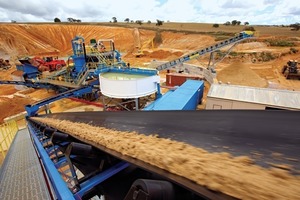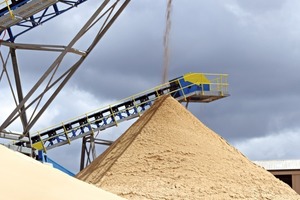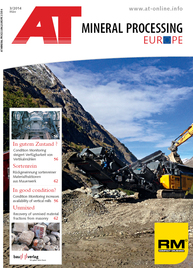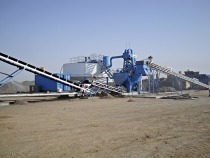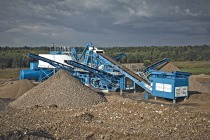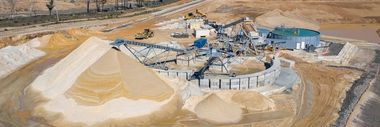Silica sand washing plant for Tooperang Quarry
Tooperang Quarry has announced the completion of a silica sand washing plant at a new site near Adelaide/South Australia (Fig. 1). The plant has been supplied by CDE and is producing glass sands for use by Owens-Illinois (O-I) at its glass bottle manufacturing plant in Adelaide.
The new turnkey plant includes a range of equipment from the CDE product portfolio including the M2500 with integrated Counter Flow Classification Unit (CFCU), EvoWash fines recovery system, fine sand screens, attrition cells and spirals. The plant configuration also includes an AquaCycle thickener which reduces the volume of fresh water required to feed the washing plant by more than 90 %. The design feed rate to the plant is 100 t/h and this produces 50 t/h of glass sand with an additional 30 t/h of concrete sand. The plant accepts -120 mm feed to the M2500 hopper and this material is then transferred to the integrated ProGrade double deck rinsing screen. The top deck removes the 40-120 mm material to a stockpile while the bottom deck sends the 7-40 mm material to another stockpile.
The 0-7 mm material collects in the ProGrade sump and is then pumped to a five deck fines screen. At this point the silica sand is screened at 0.43 mm and the 0.43-7 mm material is sent to a separate EvoWash sand washing plant to allow for the production of concrete sand. Meanwhile, the 0-0.43 mm material is sent to an EvoWash fines recovery plant where following delivery to the EvoWash sump the material is then pumped to the integrated hydrocyclone which removes the 63 µm material. The cyclone overflow containing the waste material is then sent to the AquaCycle thickener.
The underflow from the cyclone is delivered to the EvoWash dewatering screen before being transferred to the attrition cells. The function of the attrition cells is to assist with the removal of iron oxide and other deleterious materials from the silica sand. The iron oxide is adhered to the silica particles and must be scrubbed from the surface of the particles to allow removal later in the process. Refractory heavy minerals and iron oxide particles are then separated from the silica sand through the introduction of spiral classifiers. As these particles have a higher specific gravity than the silica sand particles, the spirals are able to perform the required separation. The rejects from the spirals – a sand product containing the liberated heavy mineral and iron oxide – is delivered to the EvoWash sand washing plant sump and is destined for the concrete sand product. The silica sand slurry is delivered to the sand sump on the M2500 where it is then pumped to the integrated CFCU.
The CFCU unit is used to remove the <106 mm particles from the sand as required by the specification. The CFCU is an upward flow classifying unit which operates on the principle that an upward flow of water will cause the lighter particles to rise and the heavier particles to sink. This facilitates the removal of any remaining fines while the silica sand slurry is then delivered to a dewatering screen. The dewatered silica sand is transferred via an integrated stockpile conveyor. The fine material removed in the CFCU was sent to the concrete sand Evowash for recovery into the concrete product.
From an initial iron oxide (Fe2O3) content in the feed of 0.3 % the glass sand is required to achieve 0.25 % Fe2O3 in line with O-I’s sand specification for coloured glass. The final product has less than 0.1 % iron oxide. The Fe2O3 content in the final silica sand product is reduced to 0.1 % ensuring that it meets the specification required by O-I at their Adelaide plant. “We are achieving the 0.1 % figure consistently which is as important as achieving the reduction in the iron content”, explains Chris McKeown, CDE Project Manager. Both the dewatered silica sand and concrete sands are subsequently stockpiled using 26 m radial conveyors which ensure a stockpile capacity of 5000 t (Fig. 2).
From an initial silica content of 93 % for the excavated material the final product achieves +99 % silica. Waste water from the plant is processed by the AquaCycle thickener which recovers 90 % of the water for re-circulation around the washing plant. The plant requires 400 m3/h of water for its operation and the introduction of the AquaCycle ensures that the top up water supply is only 40 m3/h. The sludge from the AquaCycle thickener is pumped to on-site settling ponds.
The glass sands produced by Tooperang Quarry will be used at O-I’s Adelaide plant in West Croydon which produces mainly wine bottles to supply Australia’s renowned wine industry. O-I’s Adelaide plant is one of four Australian O-I facilities. Across its four production plants O-I employs around 900 people and produces almost 860 000 packed tonnes of glass products or around 3.4 billion containers each year.

